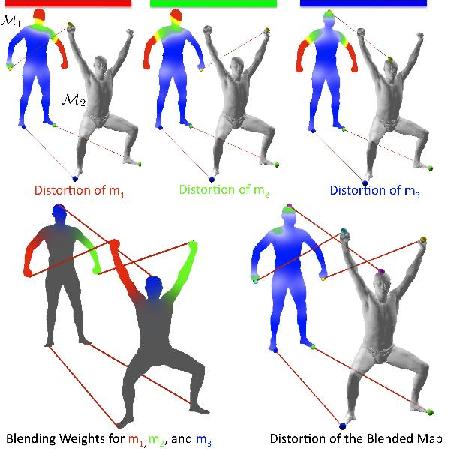Blended Intrinsic Maps
ACM Transactions on Graphics (Proc. SIGGRAPH), July 2011

A Blended Intrinsic Map combines multiple low-dimensional intrinsic maps to establish a smooth map between two surfaces with relatively low distortion. In this example, the three conformal maps (m1, m2, and m3) shown in the top row each map some part of the surface with low distorition (blue) and other parts with high distortion (red). By blending these maps with weights derived from the predicted distorition (bottom left), we can achieve lower distorition throughout the entire surface (bottom right).
Abstract
This paper describes a fully automatic pipeline for finding an intrinsic map between two non-isometric, genus zero surfaces. Our approach is based on the observation that efficient methods exist to search for nearly isometric maps (e.g., Möbius Voting or Heat Kernel Maps), but no single solution found with these methods provides low-distortion everywhere for pairs of surfaces differing by large deformations. To address this problem, we suggest using a weighted combination of these maps to produce a "blended map." This approach enables algorithms that leverage efficient search procedures, yet can provide the flexibility to handle large deformations.
The main challenges of this approach lie in finding a set of candidate maps {mi} and their associated blending weights {bi(p)} for every point p on the surface. We address these challenges specifically for conformal maps by making the following contributions. First, we provide a way to blend maps, defining the image of p as the weighted geodesic centroid of mi(p). Second, we provide a definition for smooth blending weights at every point p that are proportional to the area preservation of mi at p. Third, we solve a global optimization problem that selects candidate maps based both on their area preservation and consistency with other selected maps. During experiments with these methods, we find that our algorithm produces blended maps that align semantic features better than alternative approaches over a variety of data sets.
Paper
Project Page
Citation
Vladimir Kim, Yaron Lipman, and Thomas Funkhouser.
"Blended Intrinsic Maps."
ACM Transactions on Graphics (Proc. SIGGRAPH) 30(4), July 2011.
BibTeX
@article{Kim:2011:BIM,
author = "Vladimir Kim and Yaron Lipman and Thomas Funkhouser",
title = "Blended Intrinsic Maps",
journal = "ACM Transactions on Graphics (Proc. SIGGRAPH)",
year = "2011",
month = jul,
volume = "30",
number = "4"
}